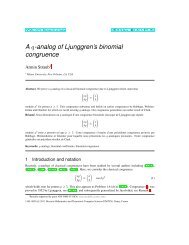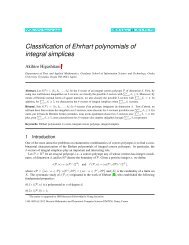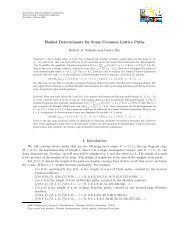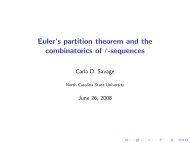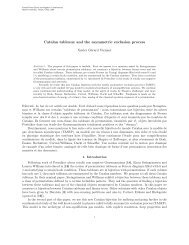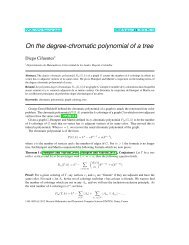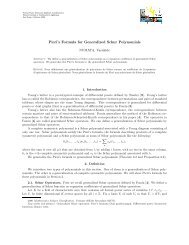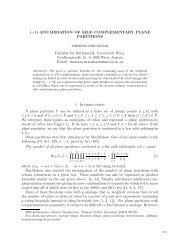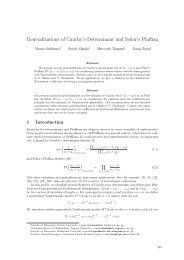The combinatorics of associated Hermite polynomials
The combinatorics of associated Hermite polynomials
The combinatorics of associated Hermite polynomials
You also want an ePaper? Increase the reach of your titles
YUMPU automatically turns print PDFs into web optimized ePapers that Google loves.
Formal Power Series and Algebraic Combinatorics<br />
Nankai University, Tianjin, China, 2007<br />
<strong>The</strong> <strong>combinatorics</strong> <strong>of</strong> <strong>associated</strong> <strong>Hermite</strong> <strong>polynomials</strong><br />
Dan Drake<br />
Abstract. We develop a combinatorial model <strong>of</strong> the <strong>associated</strong> <strong>Hermite</strong> <strong>polynomials</strong> and their moments,<br />
and prove their orthogonality with a sign-reversing involution. We find combinatorial interpretations <strong>of</strong> the<br />
moments as complete matchings, connected complete matchings, oscillating tableaux, and rooted maps and<br />
show weight-preserving bijections between these objects. Several identities, linearization formulas, and a<br />
second combinatorial model are also derived.<br />
Résumé. Nous développons un modèle combinatoire pour les polynômes de <strong>Hermite</strong> associés et leurs moments,<br />
et prouvons leur orthogonalité à l’aide d’une involution changeant le signe. Nous obtenons des interprétations<br />
combinatoires des moments en termes de couplages parfaits, de couplages parfaits connexes,<br />
de tableaux oscillants et de cartes enracinées, et nous décrivons des bijections préservant le poids entre ces<br />
familles d’objets. Plusieurs identités, des formules de linéarisation et un second modèle combinatoire en<br />
découlent.<br />
<strong>The</strong> <strong>associated</strong> <strong>Hermite</strong> <strong>polynomials</strong> are a sequence <strong>of</strong> orthogonal <strong>polynomials</strong> considered by Askey and<br />
Wimp in [AW84], who analytically derived a number <strong>of</strong> results about these <strong>polynomials</strong>. <strong>The</strong>y are also<br />
treated in [Ism05, §5.6]. In section 1 we develop a combinatorial interpretation <strong>of</strong> these <strong>polynomials</strong>, their<br />
moments, and describe an involution that proves the orthogonality and L 2 norms <strong>of</strong> the <strong>polynomials</strong> with<br />
respect to those moments. <strong>The</strong>n in section 2 we shall describe several identities and interesting linearization<br />
formulas involving <strong>associated</strong> <strong>Hermite</strong> <strong>polynomials</strong>. We finish with weight-preserving bijections between a<br />
number <strong>of</strong> classes <strong>of</strong> combinatorial objects whose generating functions all yield the moments <strong>of</strong> the <strong>associated</strong><br />
<strong>Hermite</strong>s and a second combinatorial model for the <strong>polynomials</strong>.<br />
We will assume that the reader is familiar with Viennot’s general combinatorial theory <strong>of</strong> orthogonal<br />
<strong>polynomials</strong> [Vie83, Vie85] and with the <strong>combinatorics</strong> <strong>of</strong> <strong>Hermite</strong> <strong>polynomials</strong>; see [AGV82, dSCV85,<br />
LY89] and also [Vie83, §II.6].<br />
In this abstract, (a) n denotes the rising factorial a(a + 1) · · · (a + n − 1), and a n denotes the falling<br />
factorial a(a − 1) · · · (a − k + 1). Figures in this abstract will <strong>of</strong>ten have black and green elements (usually<br />
edges in graphs). <strong>The</strong> PDF version will have the colors, <strong>of</strong> course, but in the print version, the green will<br />
appear gray. <strong>The</strong> reader should understand that green elements <strong>of</strong> figures appear gray if reading a printed<br />
version <strong>of</strong> this abstract.<br />
1. Definition and orthogonality<br />
<strong>The</strong> <strong>associated</strong> <strong>Hermite</strong> <strong>polynomials</strong> may be defined by shifting the recurrence relation for the usual<br />
<strong>Hermite</strong> <strong>polynomials</strong>, which is<br />
to<br />
H n+1 (x) = xH n (x) − nH n−1 (x),<br />
(1.1) H n+1 (x; c) = xH n (x; c) − (n + c)H n−1 (x; c),<br />
2000 Mathematics Subject Classification. Primary: 05E35; Secondary: 33C45.<br />
Key words and phrases. <strong>associated</strong> <strong>Hermite</strong> <strong>polynomials</strong>, matchings, rooted maps, oscillating tableaux.<br />
1
2 Dan Drake<br />
with H 0 (x) = H 0 (x; c) = 1 and <strong>polynomials</strong> with negative indices equal to zero. Askey and Wimp use a<br />
different normalization than we do; one obtains our normalization from plugging x/ √ 2 into their <strong>associated</strong><br />
<strong>Hermite</strong>s and dividing by (√ 2 ) n<br />
.<br />
<strong>The</strong> usual <strong>Hermite</strong> polynomial H n+1 (x) is the generating function for incomplete matchings <strong>of</strong> [n+1], in<br />
which fixed points have weight x and edges have weight −1; that combinatorial interpretation can be derived<br />
from the recurrence relation as follows: the vertex n + 1 may be fixed with weight x, times the weight <strong>of</strong> all<br />
matchings on [n]; or we may connect vertex n + 1 to any <strong>of</strong> the n vertices to its left, give the edge weight<br />
−1 and multiply by all matchings on the n − 1 remaining vertices.<br />
For the <strong>associated</strong> <strong>Hermite</strong>s, we’ll build the matchings recursively as described above and think <strong>of</strong> the<br />
parameter c as meaning that one special choice for the edge from n + 1 may have weight −1 or −c. Two<br />
natural choices are to make the special choice be the leftmost available vertex, or the rightmost available<br />
vertex. Choosing the rightmost available vertex happens to make the orthogonality involution easy to prove,<br />
and yields the following result:<br />
<strong>The</strong>orem 1.1. <strong>The</strong> nth <strong>associated</strong> <strong>Hermite</strong> polynomial is the sum over certain weighted matchings:<br />
∑<br />
(1.2) H n (x; c) =<br />
wt(M),<br />
matchings M <strong>of</strong> [n]<br />
in which fixed points have weight x, edges that nest no fixed points or edges and have no left crossings may<br />
have weight −1 or −c, and all other edges have weight −1.<br />
Pro<strong>of</strong>. We build the matching from right to left, and if at some point we add an edge and do not choose<br />
the rightmost available vertex, then that edge will nest a vertex, and when we come to that vertex, we will<br />
either leave it fixed (resulting in a fixed point underneath that edge), connect to another vertex underneath<br />
the edge (resulting in an edge nested by the original edge), or connect to a vertex to the left <strong>of</strong> the edge,<br />
resulting in a left crossing for the original edge. Any <strong>of</strong> these possibilities indicate that the rightmost vertex<br />
was not chosen, so edges for which none <strong>of</strong> those happen are “eligible” for weight −c.<br />
□<br />
An example <strong>of</strong> such a weighted matching is shown in Figure 1.<br />
−1 −1 or −c −1<br />
x<br />
Figure 1. A matching on 8 points using the rightmost-choice weighting. This weighting is<br />
used throughout this abstract.<br />
We want a linear functional L c with respect to which the <strong>associated</strong> <strong>Hermite</strong> <strong>polynomials</strong> are orthogonal.<br />
This linear functional is determined by its moments L c (x n ), which according to Viennot’s general theory,<br />
are a sum over weighted Dyck paths in which a northeast edge has weight 1 and a southeast edge leaving<br />
from height j has weight j + c. <strong>The</strong>re are no Dyck paths <strong>of</strong> odd length, so the odd moments are zero.<br />
Building matchings as in [Vie83, §II.6], we have two combinatorial interpretations for the moments:<br />
<strong>The</strong>orem 1.2. <strong>The</strong> nth moment µ n (c) <strong>of</strong> the <strong>associated</strong> <strong>Hermite</strong> <strong>polynomials</strong> is the generating function<br />
for complete matchings <strong>of</strong> [n] weighted by either (1) edges which are not nested by any other edge may have<br />
weight 1 or c, and all other edges have weight 1; or (2) edges with no right crossings may have weight 1 or<br />
c and all other edges have weight 1.<br />
<strong>The</strong> two weightings correspond to giving weight c to the leftmost and rightmost choice, respectively, in<br />
the matchings. <strong>The</strong>se interpretations also explain why the odd moments are zero, since there are no complete<br />
matchings on an odd number <strong>of</strong> vertices. For the pro<strong>of</strong> <strong>of</strong> orthogonality, we shall use the rightmost weighting;<br />
later we shall use the leftmost weighting. Figures 2 and 3 show a matching using the two weightings.
THE COMBINATORICS OF ASSOCIATED HERMITE POLYNOMIALS 3<br />
1<br />
1 or c<br />
1 or c<br />
Figure 2. A complete matching on 6 points under the leftmost-choice weighting for the moments.<br />
1 or c<br />
1<br />
1 or c<br />
Figure 3. <strong>The</strong> same complete matching under the rightmost-choice weighting. This is used<br />
in the orthogonality pro<strong>of</strong>.<br />
1.1. Pro<strong>of</strong> <strong>of</strong> orthogonality. We wish to prove the following theorem in a combinatorial manner:<br />
<strong>The</strong>orem 1.3. <strong>The</strong> <strong>associated</strong> <strong>Hermite</strong> <strong>polynomials</strong> H n (x; c) are orthogonal with respect to the linear<br />
functional L c with the above moments. <strong>The</strong>y satisfy<br />
{<br />
0 n ≠ m,<br />
(1.3) L c (H n (x; c)H m (x; c)) =<br />
(c + 1) n n = m.<br />
Pro<strong>of</strong>. <strong>The</strong> pro<strong>of</strong> proceeds very similarly to the pro<strong>of</strong> <strong>of</strong> orthogonality for usual <strong>Hermite</strong> <strong>polynomials</strong>.<br />
<strong>The</strong> product H n (x; c)H m (x; c) is the generating function for pairs <strong>of</strong> matchings with, say, black edges, using<br />
the rightmost weighting. Applying L c has the effect <strong>of</strong> putting a complete matching with the rightmost<br />
weighting with green edges on the fixed points. We will use the phrase paired matching to refer to such an<br />
object, with black homogeneous edges and arbitrary green edges, weighted as above. This is not standard<br />
terminology; it is only for our convenience.<br />
Using <strong>The</strong>orems 1.1 and 1.2, the left side <strong>of</strong> (1.3) is the generating function for paired matchings, where<br />
black edges may have weight −1 or −c if they nest no edges, have no green crossings and no left black<br />
crossing; otherwise black edges have weight −1. Green edges may have weight 1 or c if they have no right<br />
green crossing and weight 1 otherwise. See Figure 4 for an example <strong>of</strong> such an object for n = 5 and m = 3.<br />
1<br />
−1<br />
c<br />
−1<br />
Figure 4. A paired matching for n = 5 and m = 3.<br />
We need an involution that shows the generating function for paired matchings equals zero when n ≠ m,<br />
and equals (c + 1) n otherwise. Assume that n ≥ m and put [n] to the left <strong>of</strong> [m]. <strong>The</strong> involution is the very<br />
similar to that used in the combinatorial pro<strong>of</strong> <strong>of</strong> orthogonality for usual <strong>Hermite</strong> <strong>polynomials</strong>:<br />
Find the leftmost homogeneous edge in [n] that nests no other edges and change its color.<br />
For example, in Figure 4, one would change the color <strong>of</strong> the leftmost green edge that connects vertices 2<br />
and 3 to black. This operation is evidently an involution and will certainly change the sign; to complete the<br />
pro<strong>of</strong>, one verifies that the weight <strong>of</strong> no other edge is affected by this change, and that if we change the color<br />
<strong>of</strong> an edge weighted ±c, the new edge is eligible for a weight <strong>of</strong> ∓c.<br />
If n > m, there must be a homogeneous edge in [n]; in that case, the above involution has no fixed<br />
points, and we have proved that H n (x; c) is orthogonal to H m (x; c).
4 Dan Drake<br />
Now we shall prove that the L 2 norm <strong>of</strong> the <strong>associated</strong> <strong>Hermite</strong>s is (c + 1) n by interpreting the paired<br />
matchings as something whose generating function is known to be (c + 1) n : permutations weighted by leftto-right<br />
maxima. See [dMV94, FS84] for pro<strong>of</strong>s <strong>of</strong> this fact in the context <strong>of</strong> Laguerre <strong>polynomials</strong>. (“Leftto-right<br />
maxima” is “éléments saillants inférieurs gauches” in French.) This bijection naturally generalizes<br />
the usual combinatorial pro<strong>of</strong> that the L 2 norm <strong>of</strong> the <strong>Hermite</strong> <strong>polynomials</strong> is n!.<br />
First, apply the above involution to paired matchings with n = m; that involution will cancel all<br />
matchings with a homogeneous edge. To set up the bijection, begin with a matching on [n] ⊔ [n] with no<br />
homogeneous edges. Number the edges starting from the right as shown in Figure 5. Think <strong>of</strong> the right side<br />
as the domain, and the left side as the range. A simple induction argument demonstrates that edges that<br />
get weight 1 or c (here we shall think <strong>of</strong> that as having weight 1 + c) correspond exactly to digits in the<br />
permutation that are left-to-right maxima.<br />
1 2 3 4<br />
4 3 2 1<br />
Figure 5. <strong>The</strong> permutation 3142 as a matching. <strong>The</strong> right side is the domain, the left<br />
the range. <strong>The</strong> digits 3 and 4 are left-to-right maxima in the permutation, and indeed the<br />
green edges connecting to 3 and 4 on the left have weight 1+c under the <strong>associated</strong> <strong>Hermite</strong><br />
moment weighting.<br />
This bijection from the fixed points <strong>of</strong> the involution to permutations preserves weight, hence the L 2<br />
norms <strong>of</strong> the <strong>associated</strong> <strong>Hermite</strong> <strong>polynomials</strong> are (c + 1) n . This completes the pro<strong>of</strong> <strong>of</strong> <strong>The</strong>orem 1.3. □<br />
We also note that by [FS84, Lemma 2.1], the L 2 norm can also be interpreted as the generating function<br />
for permutations with cycles weighted by c + 1.<br />
2. Identities<br />
Our first result is a combinatorial pro<strong>of</strong> <strong>of</strong> the following identity, found in Askey and Wimp [AW84,<br />
equation (4.18)]:<br />
<strong>The</strong>orem 2.1. <strong>The</strong> <strong>associated</strong> <strong>Hermite</strong>s may be written as a sum <strong>of</strong> usual <strong>Hermite</strong> <strong>polynomials</strong>:<br />
(2.1) H n (x; c) = ∑ ( ) n − k<br />
(−1) k (c) k H n−2k (x).<br />
k<br />
k≥0<br />
We will need two lemmas to prove <strong>The</strong>orem 2.1. We omit their pro<strong>of</strong>s; both can be done with induction.<br />
Lemma 2.2. (−1) k (c) k is the generating function for complete matchings on 2k vertices, with the <strong>associated</strong><br />
<strong>Hermite</strong> polynomial weighting, such that all edges <strong>of</strong> weight −1 have a left crossing by an edge <strong>of</strong> weight<br />
−c. Furthermore, in such matchings there are exactly k “slots” available underneath the edges weighted −c<br />
where one could place the left endpoint <strong>of</strong> a new edge <strong>of</strong> weight −1, and only one “slot” available for the left<br />
endpoint <strong>of</strong> a new edge <strong>of</strong> weight −c.<br />
Figure 6 shows an example <strong>of</strong> such a configuration.<br />
Lemma 2.3. For such a configuration on 2k vertices as described in Lemma 2.2, there are k + 1 places<br />
where the left endpoint <strong>of</strong> one or more green edges <strong>of</strong> weight 1 could be placed without affecting the weight <strong>of</strong><br />
the configuration.<br />
Pro<strong>of</strong> <strong>of</strong> <strong>The</strong>orem 2.1. Since H n (x; c) is an even or odd polynomial if n is even or odd, respectively,<br />
we can certainly write<br />
(2.2) H n (x; c) = ∑ k≥0<br />
a nk H n−2k (x)
THE COMBINATORICS OF ASSOCIATED HERMITE POLYNOMIALS 5<br />
−c<br />
−1<br />
−c<br />
Figure 6. A matching on 6 vertices <strong>of</strong> the type described by Lemma 2.2. If the new edge<br />
on the right is to have weight −1 and satisfy the conditions, it must connect to a new vertex<br />
in one <strong>of</strong> the three available slots, indicated by the solid arrows.<br />
(<br />
for some coefficients a nk . We show that those coefficients equal (−1) k (c) n−k<br />
)<br />
k k . Fix k between 0 and n/2,<br />
multiply both sides by H n−2k (x), and apply the usual <strong>Hermite</strong> linear functional L 0 . On the right side, we<br />
use orthogonality and equation (2.2) becomes<br />
L 0 (H n (x; c)H n−2k (x)) = a nk (n − 2k)!.<br />
Thinking <strong>of</strong> the left side as paired matchings on [n] and [n − 2k] with black edges <strong>of</strong> weight −1 and −c<br />
as appropriate, and green edges all <strong>of</strong> weight 1, we may apply the following involution: find the leftmost<br />
homogeneous edge <strong>of</strong> weight ±1 in [n] or [n − 2k] and flip its color, unless that edge has a left crossing<br />
with an edge <strong>of</strong> weight −c. Swapping the colors on such edges does not preserve the weight <strong>of</strong> the paired<br />
matching.<br />
Lemma 2.2 tells us exactly what configurations <strong>of</strong> edges will remain in [n] after applying the involution;<br />
Lemma 2.3 tells us that such configurations may be viewed as consisting <strong>of</strong> k “chunks” <strong>of</strong> vertices. Placing<br />
the green edges into those chunks is equivalent to forming a weak composition <strong>of</strong> k into n − 2k + 1 parts;<br />
there are ( )<br />
n−k<br />
k such compositions, and having chosen where the n − 2k edges in [n] start, we can choose<br />
their endpoints in [n − 2k] in (n − 2k)! ways. Together we have<br />
(−1) k (c) k<br />
( n − k<br />
k<br />
which proves the identity <strong>of</strong> <strong>The</strong>orem 2.1.<br />
)<br />
(n − 2k)! = L 0 (H n (x; c)H n−2k (x)) = a nk (n − 2k)!<br />
2.1. Linearization formulas. In [Mar94, theorem 3.1], Markett shows that the linearization coefficients<br />
in<br />
(2.3) H N (x; c)H M (x; c) =<br />
are<br />
min(N,M)<br />
∑<br />
j=0<br />
f(N, M, j) H N+M−2j (x; c)<br />
(2.4) f(N, M, j) = (N + M − 2j + c + 1) j 3 F 2<br />
(<br />
j − N j − M −j<br />
j − N − M − c 1<br />
where the 3 F 2 notation indicates a hypergeometric function evaluated at x = 1. We can prove<br />
<strong>The</strong>orem 2.4. <strong>The</strong> linearization coefficients f(N, M, j) <strong>of</strong> equation (2.4) are <strong>polynomials</strong> in c with<br />
nonnegative integer coefficients.<br />
(2.5)<br />
Pro<strong>of</strong>. Omitted; it is mostly simple algebra.<br />
Note that when c = 0, the 3 F 2 <strong>of</strong> (2.4) sums by the Pfaff-Saalschütz identity to<br />
(N + 1 − j) j (M + 1 − j) j<br />
,<br />
j!<br />
and we recover the linearization coefficients for usual <strong>Hermite</strong> <strong>polynomials</strong>; the expression above, after<br />
multiplying by (N + M − 2j)!, counts inhomogeneous matchings on [n] ⊔ [m] ⊔ [n + m − 2j], as shown by<br />
de Sainte-Catherine and Viennot in [dSCV85].<br />
A combinatorial interpretation <strong>of</strong> the coefficients (2.4) is quite desirable but none is known. <strong>The</strong> best<br />
starting points seem to be [And75, Nan58, AB84]; the first two papers concern the usual Pfaff-Saalschütz<br />
identity, the third features a combinatorial pro<strong>of</strong> <strong>of</strong> the q-Pfaff-Saalschütz identity.<br />
)<br />
□<br />
□
6 Dan Drake<br />
2 4 3 4<br />
3 2 1 1<br />
∅ 2 2 4 2 3 2 3 2 ∅ 1 ∅<br />
4<br />
Figure 7. A complete matching and the corresponding oscillating tableau. <strong>The</strong> numbers<br />
in the Ferrers shapes are not, strictly speaking, part <strong>of</strong> the oscillating tableau; they are only<br />
used in the bijection from the matching to the tableau.<br />
We also have the following mixed linearization formula.<br />
<strong>The</strong>orem 2.5. If n ≥ m − 1, then<br />
(2.6) H n (x; c)H m (x) = ∑ k<br />
( )( )<br />
n + c m<br />
k!H n+m−2k (x; c),<br />
k k<br />
where the sum runs from 0 to min(m, ⌊(n + m)/2⌋).<br />
Pro<strong>of</strong>. Omitted. One uses induction and the recurrence relations for the induction step.<br />
□<br />
3. Associated <strong>Hermite</strong> moments and oscillating tableaux<br />
In this section we will describe a statistic on oscillating tableaux, also known as up-down tableaux, and<br />
a bijection from these tableaux to complete matchings which is weight-preserving when using the weight for<br />
<strong>associated</strong> <strong>Hermite</strong> moments. Oscillating tableaux were described by Sundaram [Sun90]; see section 5 <strong>of</strong><br />
[CDD + 07] for discussion <strong>of</strong> their origins and the bijection to complete matchings. Briefly, an oscillating<br />
tableau is a path in the Hasse diagram <strong>of</strong> the Young lattice in which at each point one either moves up to<br />
a partition that covers the current partition, or moves down to a partition covered by the current partition.<br />
For our purposes, the path will always begin and end with the empty shape. <strong>The</strong> length <strong>of</strong> an oscillating<br />
tableau is the number <strong>of</strong> edges in the path. Figure 8 has an example <strong>of</strong> an oscillating tableau <strong>of</strong> length 8.<br />
In this section, we use <strong>The</strong>orem 1.2’s “leftmost-available” weighting <strong>of</strong> complete matchings, in which<br />
edges that are not nested by other edges may have weight 1 or c, and all other edges have weight 1.<br />
Roughly speaking, the bijection from complete matchings to oscillating tableaux works by RSK-inserting<br />
numbers when edges start, and deleting them when edges end. More precisely, given a complete matching,<br />
number the edges from right to left as in Figure 7. (Equivalently, write the matching as a double occurrence<br />
word; see section 4.) We will map this matching to a sequence <strong>of</strong> Ferrers shapes. Begin with the empty<br />
Ferrers shape and read the matching left to right. When edge j starts, RSK-insert a j into the tableau; when<br />
edge j ends, delete the box containing j. When done, erase the numbers in the Ferrers shapes. Figure 7 has<br />
an example.<br />
<strong>The</strong>re is a possible point <strong>of</strong> confusion here. A tableau in this context is a path in the Hasse diagram <strong>of</strong><br />
the Young lattice—a sequence <strong>of</strong> Ferrers shapes. A standard Young tableau is a path that continually moves<br />
up, and therefore it is simple to record the path with a single Ferrers shape filled with numbers that strictly<br />
increase in rows and columns. In Figure 7, the Ferrers shapes are written as Young tableaux, which is only<br />
for our convenience. <strong>The</strong> actual image <strong>of</strong> the complete matching is the same sequence without the numbers<br />
in the shapes. <strong>The</strong> reason for this is that RSK is a bijection, and one can unbump numbers.<br />
Figure 8 describes the inverse map from tableaux to matchings. We read the sequence <strong>of</strong> Ferrers shapes<br />
from right to left. Because <strong>of</strong> how we number the edges, the first box must have a 1 in it. In general, when<br />
the shape gets larger, we put the next-largest number into the new box, because we’ve started a new edge.<br />
<strong>The</strong> third shape from the right is 1 3 2 , and the shape to its left must be 1 3 , because unbumping the 2 is the<br />
only way to produce the second shape. This oscillating tableau corresponds to the matching 43412321, using<br />
the vertex-numbering scheme described above.
THE COMBINATORICS OF ASSOCIATED HERMITE POLYNOMIALS 7<br />
∅<br />
∅<br />
Figure 8. An oscillating tableau that corresponds to the complete matching (13)(26)(48)(57).<br />
Let us weight oscillating tableaux with the following statistic: numbers that appear in the first column<br />
have weight 1 or c, and all other numbers have weight 1. That statistic is exactly what we need to prove the<br />
following theorem.<br />
<strong>The</strong>orem 3.1. <strong>The</strong>re is a weight-preserving bijection between oscillating tableaux <strong>of</strong> length 2n weighted<br />
with the above statistic and complete matchings weighted with the leftmost-available <strong>associated</strong> <strong>Hermite</strong><br />
weighting.<br />
We will use several preliminary results to prove this theorem.<br />
Lemma 3.2. In an oscillating tableau, when a number is added to a shape, the corresponding edge is<br />
nested by all edges whose corresponding number in the shape is smaller, and has a left crossing from all<br />
edges whose corresponding number in the shape is bigger. Edges whose corresponding numbers never appear<br />
together in a shape neither nest nor cross one another.<br />
For example, when we move from 2 4 to 2 3<br />
4 in Figure 7, edge 3 is nested by edge 2 and has a left crossing<br />
from edge 4. <strong>The</strong> pro<strong>of</strong> <strong>of</strong> this is left to the reader; it follows from the way the edges are numbered and in<br />
what order we add numbers to the tableau.<br />
<strong>The</strong> above lemma implies the following facts:<br />
Proposition 3.1. In an oscillating tableau, edges that get nested by other edges are exactly those whose<br />
number appears in the 2nd, 3rd, etc, column <strong>of</strong> a shape. Edges that have a right crossing are exactly those<br />
whose number appears in the 2nd, 3rd, etc row <strong>of</strong> a shape.<br />
Pro<strong>of</strong> <strong>of</strong> <strong>The</strong>orem 3.1. <strong>The</strong> bijection between complete matchings and oscillating tableaux clearly<br />
preserves weight: edges that do not get nested by another edge must appear in the first column only. Note<br />
also that we could have used the rightmost-available weighting from <strong>The</strong>orem 1.2; in that case, we would<br />
have needed to make our statistic “entries that appear in the first row and stay there get weight 1 or c”. □<br />
4. Associated <strong>Hermite</strong> moments, rooted maps, and connected matchings<br />
In addition to the weight-preserving bijection between <strong>associated</strong> <strong>Hermite</strong> moments and oscillating<br />
tableaux <strong>of</strong> section 3, there is a weight-preserving bijection between <strong>associated</strong> <strong>Hermite</strong> moments and rooted<br />
maps. See [Tut73, JV00] for introductions to maps. A map may be thought <strong>of</strong> as a graph along with<br />
an embedding into a surface. A rooted map is a map in which one edge has been oriented. <strong>The</strong>re is an<br />
axiomatic construction <strong>of</strong> maps that makes it natural to think <strong>of</strong> the edges in a map as pairs <strong>of</strong> half-edges<br />
or edge ends and we will speak <strong>of</strong> edge ends in this section.<br />
This connection was motivated by setting c = 1; if we have a polynomial that we suspect is the generating<br />
function for some objects, setting c to 1 gives us a count <strong>of</strong> how many objects there are, which facilitates<br />
searching. Doing so yields<br />
1, 1, 2, 10, 74, 706, 8162, 110410, 1708394, . . .<br />
which is sequence A000698 in [Slo]. This sequence likely first appeared in [Tou52]; it counts connected<br />
matchings (see below).<br />
In Table 1 <strong>of</strong> [AB00, page 10], Arquès and Béraud count rooted maps by number <strong>of</strong> edges and vertices;<br />
that table also describes <strong>associated</strong> <strong>Hermite</strong> moments: the entry in the nth row and mth column is the<br />
number <strong>of</strong> rooted maps with n edges and m vertices, and is also the coefficient <strong>of</strong> c m−1 in µ 2n (c). We will<br />
weight each vertex in such a map by c except the vertex at the head <strong>of</strong> the root edge, and use the bijection<br />
between rooted maps in orientable surfaces and connected matchings found in the work <strong>of</strong> Ossona de Mendez<br />
and Rosenstiehl [OdMR05, OdMR99]. A connected matching on 2n vertices is one in which all vertices<br />
except 1 and 2n are nested by an edge. Equivalently, one can write a matching as a double occurrence<br />
word in the letters 1, 2, . . . , n where each letter appears exactly twice; then a matching is connected if the
8 Dan Drake<br />
corresponding double occurrence word cannot be written as the concatenation <strong>of</strong> two double occurrence<br />
words.<br />
A double occurrence word is the same thing as the vertex-numbering scheme used in section 3. We shall<br />
weight connected matchings by giving weight c to all nonnested edges except the edge containing vertex 1.<br />
<strong>The</strong>n we have<br />
<strong>The</strong>orem 4.1. <strong>The</strong> function given in [OdMR05] and [OdMR99] is a weight-preserving bijection from<br />
rooted maps in orientable surfaces with k vertices and n edges to connected matchings on 2n + 2 vertices <strong>of</strong><br />
weight c k−1 .<br />
Pro<strong>of</strong>. <strong>The</strong> idea <strong>of</strong> the bijection is this: number the edges in the rooted map, add a new loop at the<br />
vertex adjacent to the root, then build a double occurrence word by visiting each vertex and adding the edge<br />
numbers adjacent to the vertex to the word.<br />
<strong>The</strong> bijection is weight-preserving because when deciding the next vertex to visit, the algorithm chooses<br />
the vertex in the rooted map corresponding to the leftmost unattached vertex in the partially-constructed<br />
matching. As we add edge ends to the list, we will add a new edge to the matching that contains that<br />
leftmost unattached vertex. No edge can then nest the newly created edge, so every visit to a new vertex in<br />
the rooted map results in exactly one nonnested edge in the matching.<br />
□<br />
Figure 9 shows an example <strong>of</strong> the bijection. We will color green the vertices <strong>of</strong> weight c in the rooted<br />
map and the edges <strong>of</strong> weight c in the connected matching. We start at the head <strong>of</strong> edge α and read<br />
counterclockwise around vertex a; our initial double occurrence word is<br />
α 1 2 3 α.<br />
We have visited both ends <strong>of</strong> α, so we move to the unvisited end <strong>of</strong> edge 1, go around vertex b and add<br />
4 4 5 2 5 1 to the word, which is now<br />
α 1 2 3 α 4 4 5 2 5 1.<br />
Now move to the unvisited end <strong>of</strong> edge 3 and do the same thing; we just append 3 to the word. We end up<br />
with<br />
α 1 2 3 α 4 4 5 2 5 1 3,<br />
which is double-occurence word for the connected matching (1, 5)(2, 11)(3, 9)(4, 12)(6, 7)(8, 10) where the<br />
edges incident to vertices 11 and 12 have weight c because edges 1 and 3 in the rooted map were the edges<br />
along which we first visited vertices b and c.<br />
c<br />
3<br />
a<br />
2<br />
5<br />
b<br />
α<br />
1<br />
4<br />
Figure 9. A rooted map to which we’ll apply the bijection to connected matchings. Green<br />
vertices have weight c. We have already added the extra edge, labeled α; the original root<br />
was the end <strong>of</strong> edge 1 incident with vertex a.<br />
Now we need another weight-preserving bijection, this time from weighted connected matchings to one<br />
<strong>of</strong> our original definitions for the moments <strong>of</strong> <strong>associated</strong> <strong>Hermite</strong> <strong>polynomials</strong>. We will demonstrate such a<br />
bijection to the moments weighted with the leftmost-available weighting <strong>of</strong> <strong>The</strong>orem 1.2, in which nonnested<br />
edges are eligible for weight c. Call the edge containing vertex 1 the “fake edge”.<br />
<strong>The</strong> bijection works as follows: If the fake edge has no crossings, remove it; the remaining matching on<br />
2n vertices, <strong>of</strong> weight 1, is the result <strong>of</strong> the bijection. Otherwise, swap the tails <strong>of</strong> the fake edge and that<br />
edge crossing the fake edge which has the leftmost endpoint. That crossing edge must have weight c; give the<br />
new edge, which is now nested by the fake edge, weight c also. Continue this tail-swapping process with the<br />
fake edge until the fake edge has no crossings, then remove it. <strong>The</strong> reader may wish to work out an example,<br />
and show that the connected matching (1, 5)(2, 4)(3, 8)(6, 7) corresponds to the matching (1, 3)(2, 4)(5, 6).
THE COMBINATORICS OF ASSOCIATED HERMITE POLYNOMIALS 9<br />
Table 1. A rooted map, a connected matching, a complete matching, and an oscillating<br />
tableau, all <strong>of</strong> weight c 5 , that correspond to each other using the weight-preserving bijections<br />
<strong>of</strong> this abstract. In the tableau, we have only colored the first box that corresponds to a<br />
number which gets weight c.<br />
Object<br />
What gets weight c<br />
Vertices not adjacent<br />
to head <strong>of</strong> root edge.<br />
Non-nested edges except<br />
edge containing<br />
vertex 1.<br />
(1, 6)(2, 8)(3, 12)(4, 17)(5, 15)(7, 20)(9, 22)(10, 11)(13, 18)(14, 16)(19, 21)<br />
Non-nested edges may<br />
have weight 1 or c.<br />
(1, 5)(2, 7)(3, 11)(4, 14)(6, 16)(8, 19)(9, 10)(12, 17)(13, 15)(18, 20)<br />
∅<br />
∅<br />
Numbers that appear<br />
in first column may<br />
have weight 1 or c.<br />
This map is a bijection because it can be reversed: given such a weighted matching on 2n vertices, add<br />
a new edge that nests the entire matchings, and swap tails with the green edges (those <strong>of</strong> weight c) from<br />
right to left. Observe that the green edges in the connected matching—which are nonnested—will end up<br />
nonnested after the tail-swapping bijection, and vice versa, so this bijection is weight-preserving.<br />
<strong>The</strong>orem 4.1 established that the generating functions for rooted maps and connected matchings are<br />
the same; that theorem, together with the bijection between connected matchings and arbitrary complete<br />
matchings, provides a pro<strong>of</strong> <strong>of</strong> the following theorem.<br />
<strong>The</strong>orem 4.2. <strong>The</strong> generating functions for rooted maps with n edges, connected matchings on 2n +<br />
2 vertices, and complete matchings on 2n vertices all equal the moment µ 2n <strong>of</strong> the <strong>associated</strong> <strong>Hermite</strong><br />
<strong>polynomials</strong>.<br />
In the last two sections, we’ve shown bijections between the moments <strong>of</strong> the <strong>associated</strong> <strong>Hermite</strong>s, connected<br />
matchings, rooted maps and oscillating tableaux. We summarize these correspondences by going all<br />
the way from a rooted map, to a connected matching, to a regular complete matching, to an oscillating<br />
tableau in Table 1.<br />
4.1. A second model for <strong>associated</strong> <strong>Hermite</strong> <strong>polynomials</strong>. <strong>The</strong> above discussion <strong>of</strong> connected<br />
matchings meshes nicely with a second combinatorial model <strong>of</strong> the <strong>associated</strong> <strong>Hermite</strong>s, which is motivated
10 Dan Drake<br />
+1 −c<br />
−1<br />
−1<br />
x<br />
Figure 10. A matching on 9 vertices that contributes cx to H 7 (x; c) using the combinatorial<br />
interpretation <strong>of</strong> <strong>The</strong>orem 4.3. Note the “fake edge” <strong>of</strong> weight +1.<br />
by identity (2.1):<br />
H n (x; c) = ∑ ( ) n − k<br />
(−1) k (c) k H n−2k (x).<br />
k<br />
k≥0<br />
<strong>The</strong> key features <strong>of</strong> this second model are very similar to those <strong>of</strong> the connected matching model for the<br />
moments: there are no choices for the weights <strong>of</strong> parts <strong>of</strong> the matching, and the resulting matching is<br />
connected.<br />
<strong>The</strong>orem 4.3. <strong>The</strong> <strong>associated</strong> <strong>Hermite</strong> polynomial H n (x; c) is the generating function for certain connected<br />
incomplete matchings on n + 2 vertices with the following weights:<br />
• <strong>The</strong> edge containing vertex 1 has weight 1. Call this edge the “fake edge”.<br />
• Fixed points have weight x.<br />
• Non-nested edges (except the fake edge) have weight −c.<br />
• Nested edges have weight −1.<br />
In such matchings, fixed points must be nested by the fake edge. All edges other than the fake edge must<br />
either cross or be nested by the fake edge.<br />
An example <strong>of</strong> such a matching for H 7 (x; c) is shown in Figure 10. It is clear that the requirement for<br />
nesting and crossing the fake edge yields a connected matching. Note that the connected matching moments<br />
<strong>of</strong> section 4 also have a fake edge.<br />
Pro<strong>of</strong>. Consider the kth term in the sum (2.1):<br />
(−1) k (c) k<br />
( n − k<br />
k<br />
)<br />
H n−2k (x).<br />
Begin with the fake edge and put k vertices to the right <strong>of</strong> it. Put the remaining n − k vertices underneath<br />
the fake edge and choose k <strong>of</strong> them to connect with the edges that will come from the k vertices on the right<br />
<strong>of</strong> the fake edge; that accounts for the binomial coefficient. On the remaining n − 2k vertices underneath the<br />
fake edge, we put a regular <strong>Hermite</strong>-style matching; all the edges will have weight −1 since they are nested<br />
by the fake edge.<br />
<strong>The</strong> last thing to do is account for the k edges that come from the right <strong>of</strong> the fake edge and show that<br />
they contribute (−1) k (c) k . According to Lemma 4.4, the generating function for such a configuration with<br />
the edges <strong>of</strong> weight +1 and +c is (c + 1) k−1 , but in our subset, the leftmost edge also gets weight c, so the<br />
correct factor is (c + 1) k−1 · c = (c) k . Also, we must correct for the signs: our edges have weight −1 and −c,<br />
so we multiply by (−1) k .<br />
□<br />
Another pro<strong>of</strong> goes by verifying that the generating function described in the theorem satisfies the<br />
three-term recurrence for the <strong>associated</strong> <strong>Hermite</strong>s (1.1).<br />
<strong>The</strong> following lemma was used in the pro<strong>of</strong> <strong>of</strong> <strong>The</strong>orem 4.3. It may be proved by induction, similar to<br />
Lemma 2.2.<br />
Lemma 4.4. <strong>The</strong> generating function for complete matchings on 2n vertices in which all edges go from<br />
the “left n” vertices to the “right n” vertices , with all nonnested edges having weight c except the edge<br />
containing the leftmost vertex, is (c + 1) n−1 .<br />
<strong>The</strong>re is a weight-preserving bijection between such matchings and permutations π <strong>of</strong> [n] weighted by<br />
c LRM(π)−1 where LRM(π) is the number <strong>of</strong> left-to-right-maxima <strong>of</strong> the permutation.
THE COMBINATORICS OF ASSOCIATED HERMITE POLYNOMIALS 11<br />
At this point, we have a combinatorial interpretation for both the <strong>associated</strong> <strong>Hermite</strong> <strong>polynomials</strong><br />
(<strong>The</strong>orem 4.3) and their moments (<strong>The</strong>orem 4.2) in terms <strong>of</strong> connected matchings with a fake edge; the<br />
natural thing to do is combine these to get another pro<strong>of</strong> <strong>of</strong> orthogonality. This will be quite difficult<br />
because it is not at all obvious how to combine a pair <strong>of</strong> matchings for the <strong>polynomials</strong> and a matching for<br />
the moments to get a paired matching; one would have two fake edges from the <strong>polynomials</strong> and would need<br />
to somehow incorporate the fake edge from the moments into that configuration.<br />
5. Unanswered questions and future directions<br />
We have taken the basic combinatorial model in section 1 for <strong>associated</strong> <strong>Hermite</strong> <strong>polynomials</strong> and their<br />
moments and gone in two directions: to oscillating tableaux, and to rooted maps. <strong>The</strong> appeal <strong>of</strong> oscillating<br />
tableaux is in the recent flurry <strong>of</strong> work on k-crossings and k-nestings in matchings and set partitions; see<br />
[CDD + 07, Kra06, dM06, Kla05, KZ06, Jel07]. <strong>The</strong> moments <strong>of</strong> Charlier <strong>polynomials</strong> are generating<br />
functions for set partitions and it seems likely that some <strong>of</strong> this work could be used to treat the <strong>associated</strong><br />
Charlier <strong>polynomials</strong>.<br />
One disadvantage <strong>of</strong> the original combinatorial model and oscillating tableaux is that certain parts <strong>of</strong><br />
the corresponding combinatorial objects may have weight 1 or c. This makes pro<strong>of</strong>s <strong>of</strong> linearization formulas<br />
and other identities more difficult because our pro<strong>of</strong>s are generally “geometric” in nature, in the sense that<br />
they depend on the pictorial representation <strong>of</strong> the objects; we use words like “leftmost” and make other<br />
spatial references. In such pro<strong>of</strong>s it is desirable to have a 1-1 correspondence between terms that contribute<br />
to the generating function and geometric objects. This makes the sign-reversing involutions we need to find<br />
much easier.<br />
Sending c to c − 1 seems like a solution to this problem, but it would really just shuffle it around: as<br />
it stands, the moment weighting for complete matchings on 2n points has “1 or c edges”, but the weighting<br />
for connected complete matchings on 2n + 2 points only has edges <strong>of</strong> weight c. Shifting c to c − 1 would fix<br />
the problem for matchings on 2n vertices, but would give our connected matchings edges <strong>of</strong> weight c or −1,<br />
which is undesirable for the moments.<br />
Observe that in the connected matchings, the rooted maps, and in the second combinatorial model for<br />
the associate <strong>Hermite</strong> <strong>polynomials</strong> <strong>of</strong> <strong>The</strong>orem 4.3, each model has some sort <strong>of</strong> “fake edge”. Combining<br />
the models for the moments and <strong>polynomials</strong> which both involve connected matchings would be fruitful and<br />
eliminate the problems with multiple choices for the weights discussed above, but this has not yet shown<br />
promise. A major problem is that each incomplete matching for the polynomial is weighted by x to the<br />
number <strong>of</strong> fixed points—say there are 2k fixed points—but the corresponding matchings are matchings on<br />
2k + 2 vertices. It is not clear how to combine these two objects in a geometric or graph-theoretical way<br />
that allows a natural and easy pro<strong>of</strong> <strong>of</strong> orthogonality.<br />
Using rooted maps holds promise, though: de Mendez and Rosenstiehl have generalized the bijection<br />
between connected matchings and rooted maps to a bijection between permutations and hypermaps<br />
[OdMR04, OdMR99]. This suggests an intriguing connection to Laguerre <strong>polynomials</strong> since hypermaps<br />
are built out <strong>of</strong> permutations in the same way that maps are built out <strong>of</strong> complete matchings. <strong>The</strong> paper<br />
<strong>of</strong> Askey and Wimp [AW84] which inspired this work devotes much more attention to the <strong>associated</strong> Laguerres<br />
than to <strong>Hermite</strong>s—about two-thirds <strong>of</strong> the article. It is natural, then, to work out a corresponding<br />
combinatorial treatment <strong>of</strong> those <strong>polynomials</strong>, especially given the connections between rooted maps and<br />
hypermaps. <strong>The</strong>re is also the work <strong>of</strong> Ismail et al [ILV88] who work with the <strong>associated</strong> Laguerres as birth<br />
and death processes—there has been work on birth and death processes and lattice paths [FG00] which<br />
suggests another avenue for a combinatorial theory <strong>of</strong> those <strong>polynomials</strong>.<br />
6. Acknowledgements<br />
This work is based on part <strong>of</strong> the author’s doctoral thesis, completed at the University <strong>of</strong> Minnesota<br />
under the direction <strong>of</strong> Dennis Stanton. <strong>The</strong> author thanks Pr<strong>of</strong>essor Stanton for his assistance and patience,<br />
the University <strong>of</strong> Minnesota math department for their support, and the referees for their careful reading<br />
and helpful comments.<br />
References<br />
[AB84]<br />
George E. Andrews and David M. Bressoud, Identities in <strong>combinatorics</strong> III: Further aspects <strong>of</strong> ordered set sorting,<br />
Discrete Math. 49 (1984), no. 3, 223–236, doi:10.1016/0012-365X(84)90159-6. MR 0743793.
12 Dan Drake<br />
[AB00] Didier Arquès and Jean-François Béraud, Rooted maps on orientable surfaces, Riccati’s equation and continued<br />
fractions, Discrete Math. 215 (2000), no. 1-3, 1–12, doi:10.1016/S0012-365X(99)00197-1. MR 1746444.<br />
[AGV82] Ruth Azor, J. Gillis, and J. D. Victor, Combinatorial applications <strong>of</strong> <strong>Hermite</strong> <strong>polynomials</strong>, SIAM J. Math. Anal.<br />
13 (1982), no. 5, 879–890, doi:10.1137/0513062. MR 0668329.<br />
[And75] George E. Andrews, Identities in <strong>combinatorics</strong> I: On sorting two ordered sets, Discrete Math. 11 (1975), 97–106,<br />
doi:10.1016/0012-365X(75)90001-1. MR 0389609.<br />
[AW84] Richard Askey and Jet Wimp, Associated Laguerre and <strong>Hermite</strong> <strong>polynomials</strong>, Proc. Roy. Soc. Edinburgh Sect. A<br />
96 (1984), no. 1-2, 15–37. MR 741641.<br />
[CDD + 07] William Y. C. Chen, Eva Y. P. Deng, Rosena R. X. Du, Richard P. Stanley, and Catherine H. Yan, Crossings<br />
and nestings <strong>of</strong> matchings and partitions, Transactions <strong>of</strong> the American Mathematical Society 359 (2007), no. 4,<br />
1555–1575, doi:10.1090/S0002-9947-06-04210-3.<br />
[dM06] Anna de Mier, k-noncrossing and k-nonnesting graphs and fillings <strong>of</strong> Ferrers diagrams, Feb 2006,<br />
arXiv:math.CO/0602195.<br />
[dMV94] Anne de Médicis and Xavier G. Viennot, Moments des q-polynômes de Laguerre et la bijection de Foata-Zeilberger,<br />
Adv. in Appl. Math. 15 (1994), no. 3, 262–304, doi:10.1006/aama.1994.1010. MR 1288802.<br />
[dSCV85] Myriam de Sainte-Catherine and Gérard Viennot, Combinatorial interpretation <strong>of</strong> integrals <strong>of</strong> products <strong>of</strong> <strong>Hermite</strong>,<br />
Laguerre and Tchebycheff <strong>polynomials</strong>, Lecture Notes in Mathematics, vol. 1171, pp. 120–128, Springer-Verlag,<br />
Berlin, 1985. MR 0838977.<br />
[FG00] Philippe Flajolet and Fabrice Guillemin, <strong>The</strong> formal theory <strong>of</strong> birth-and-death processes, lattice path <strong>combinatorics</strong><br />
and continued fractions, Adv. in Appl. Probab. 32 (2000), no. 3, 750–778, doi:10.1239/aap/1013540243. MR 1788094.<br />
[FS84] Dominique Foata and Volker Strehl, Combinatorics <strong>of</strong> Laguerre <strong>polynomials</strong>, Enumeration and design (Waterloo,<br />
Ont., 1982), Academic Press, Toronto, ON, 1984, pp. 123–140. MR 782311.<br />
[ILV88] Mourad E. Ismail, Jean Letessier, and Galliano Valent, Linear birth and death models and <strong>associated</strong> Laguerre and<br />
Meixner <strong>polynomials</strong>, J. Approx. <strong>The</strong>ory 55 (1988), no. 3, 337–348, doi:10.1016/0021-9045(88)90100-1. MR 0968940.<br />
[Ism05] Mourad E. H. Ismail, Classical and quantum orthogonal <strong>polynomials</strong> in one variable, Encyclopedia <strong>of</strong> Mathematics<br />
and its Applications, Cambridge University Press, November 2005. ISBN 0521782015.<br />
[Jel07] Vít Jelínek, Dyck paths and pattern-avoiding matchings, European J. Combin. 28 (2007), no. 1, 202–213,<br />
doi:10.1016/j.ejc.2005.07.013. MR 2261812.<br />
[JV00] David Jackson and Terry Visentin, An atlas <strong>of</strong> the smaller maps in orientable and nonorientable surfaces, Chapman<br />
& Hall/CRC, September 2000. ISBN 1584882077.<br />
[Kla05] Martin Klazar, On identities concerning the numbers <strong>of</strong> crossings and nestings <strong>of</strong> two edges in matchings, Mar<br />
2005, arXiv:math.CO/0503012.<br />
[Kra06] C. Krattenthaler, Growth diagrams, and increasing and decreasing chains in fillings <strong>of</strong> ferrers shapes, Adv. in Appl.<br />
Math. 37 (2006), no. 3, 404–431, doi:10.1016/j.aam.2005.12.006. MR 2261181.<br />
[KZ06] Anisse Kasraoui and Jiang Zeng, Distribution <strong>of</strong> crossings, nestings and alignments <strong>of</strong> two edges in matchings and<br />
partitions, Electron. J. Combin. 13 (2006), no. 1. MR 2212506.<br />
[LY89] Jacques Labelle and Yeong N. Yeh, <strong>The</strong> <strong>combinatorics</strong> <strong>of</strong> Laguerre, Charlier, and <strong>Hermite</strong> <strong>polynomials</strong>, Stud. Appl.<br />
Math. 80 (1989), no. 1, 25–36. MR 1002302.<br />
[Mar94] Clemens Markett, Linearization <strong>of</strong> the product <strong>of</strong> symmetric orthogonal <strong>polynomials</strong>, Constr. Approx. 10 (1994),<br />
no. 3, 317–338, doi:10.1007/BF01212564. MR 1291053.<br />
[Nan58] T. S. Nanjundiah, Remark on a note <strong>of</strong> P. Turán, Amer. Math. Monthly 65 (1958), 354. MR 98042.<br />
[OdMR99] Patrice Ossona de Mendez and Pierre Rosenstiehl, Connected permutations and hypermaps, Tech. Report 183, Centre<br />
d’Analyse et de Mathématique Sociales, July 1999, http://citeseer.ist.psu.edu/demendez99connected.html.<br />
[OdMR04] , Transitivity and connectivity <strong>of</strong> permutations, Combinatorica 24 (2004), no. 3, 487–501, doi:10.1007/s00493-<br />
004-0029-4. MR 2085369.<br />
[OdMR05] , Encoding pointed maps by double occurrence words, August 2005, http://hal.ccsd.cnrs.fr/<br />
ccsd-00007477.<br />
[Slo] N. J. A. Sloane, <strong>The</strong> on-line encyclopedia <strong>of</strong> integer sequences, sequence A000698, http://www.research.att.com/<br />
~njas/sequences/A000698.<br />
[Sun90] Sheila Sundaram, <strong>The</strong> Cauchy identity for Sp(2n), J. Combin. <strong>The</strong>ory Ser. A 53 (1990), no. 2, 209–238,<br />
doi:10.1016/0097-3165(90)90058-5. MR 1041446.<br />
[Tou52] Jacques Touchard, Sur un problème de configurations et sur les fractions continues, Canadian J. Math. 4 (1952),<br />
2–25. MR 46325.<br />
[Tut73] William T. Tutte, What is a map?, New directions in the theory <strong>of</strong> graphs (Proc. Third Ann Arbor Conf., Univ.<br />
Michigan, Ann Arbor, Mich., 1971), Academic Press, New York, 1973, pp. 309–325. MR 0376413.<br />
[Vie83] Gérard Viennot, Une théorie combinatoire des pôlynomes othogonaux generaux, Sep-Oct 1983, Notes from a conference<br />
at the Université du Québec à Montréal.<br />
[Vie85]<br />
, A combinatorial theory for general orthogonal <strong>polynomials</strong> with extensions and applications, Lecture Notes<br />
in Mathematics, vol. 1171, pp. 139–157, Springer-Verlag, Berlin, 1985. MR 838979.<br />
School <strong>of</strong> Mathematics, University <strong>of</strong> Minnesota, Minneapolis, MN, USA<br />
E-mail address: ddrake@member.ams.org<br />
URL: http://www.math.umn.edu/~drake



